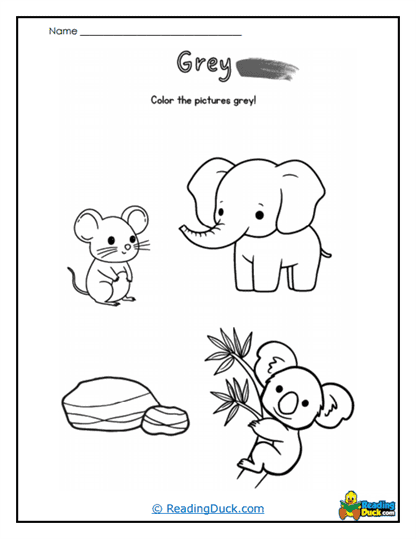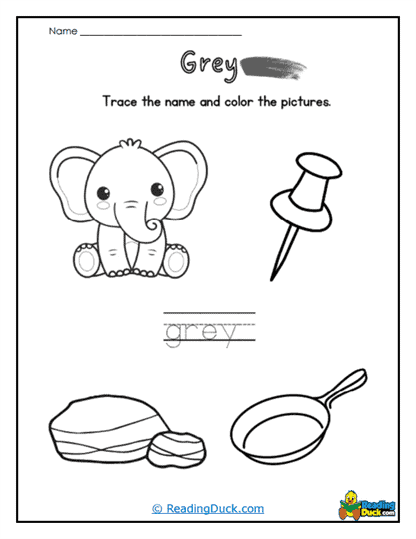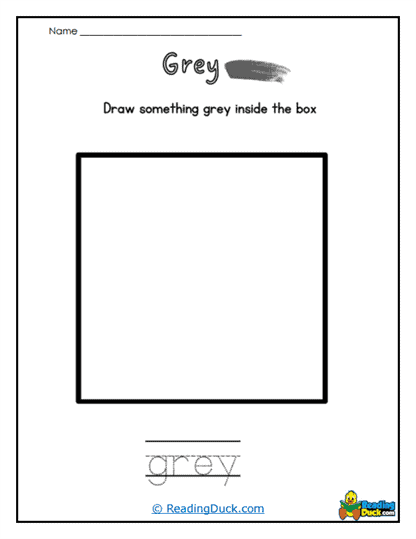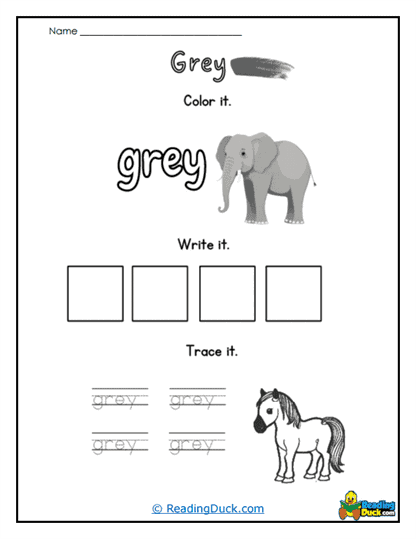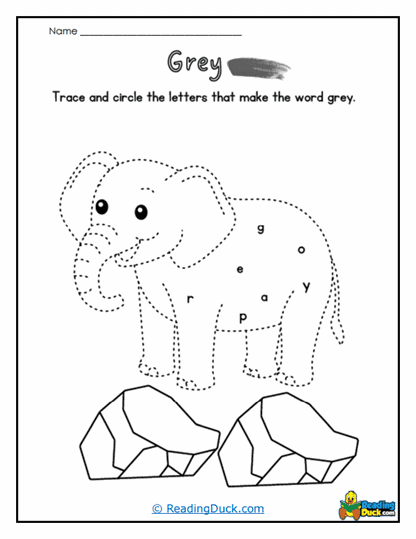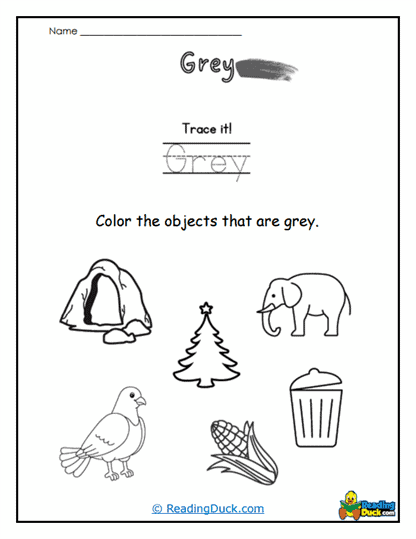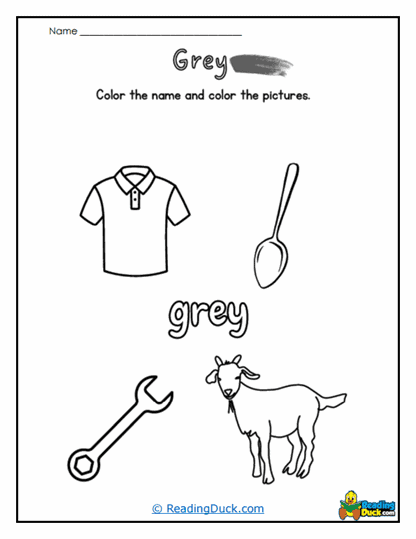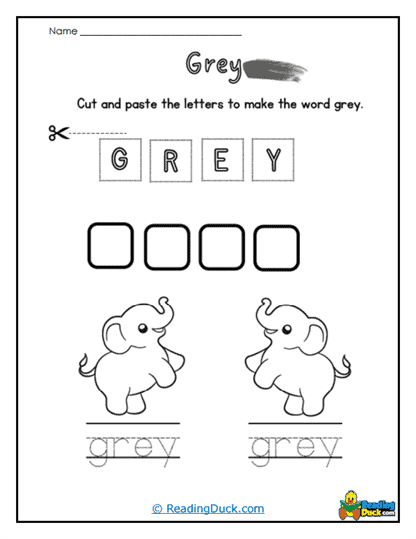Grey Worksheets
About Our Color Grey Worksheets
This collection of worksheets offer an engaging introduction to color recognition, specifically focusing on the color grey, for young students. These worksheets are designed to help early learners recognize, differentiate, and become familiar with grey through various interactive activities. Each sheet targets early childhood skills, including tracing, matching, cutting, and coloring, to reinforce color learning in an enjoyable and hands-on way. Such activities encourage students to understand grey as more than a color, associating it with objects, animals, and everyday items they recognize.
By using these worksheets, teachers can create a learning environment where students explore colors through playful tasks, making learning both fun and educational. The color grey is introduced through objects that children might already be familiar with, such as elephants, rocks, and clouds. Through these familiar associations, students build a foundational understanding of grey that goes beyond just identifying a color, helping them establish connections to the natural and manmade world.
These worksheets emphasize sensory learning, where students are not only observing but also actively engaging with grey through touch, sight, and hand coordination. For instance, cutting and pasting activities foster fine motor skills, while color-matching exercises improve visual differentiation abilities. Teachers and homeschoolers can use these worksheets as stand-alone tasks or integrate them into broader lessons on colors, animals, or everyday objects.
These worksheets aim to develop early literacy and language skills by incorporating word tracing and letter identification. Young learners can trace the word "grey," familiarize themselves with its spelling, and visually reinforce their understanding of the word through repetition and hands-on practice.
The collection provides a well-rounded educational experience for children. They are more than just color learning sheets; they are tools that develop literacy, fine motor skills, and critical thinking, making them a valuable addition to any early learning curriculum.
Types of Exercises
The worksheets include a diverse range of exercises, each targeting different aspects of color recognition and early learning. One type of exercise is color identification and matching, where students are prompted to select grey-colored items from a set of colorful images. This task encourages children to actively look for grey in a fun and visually stimulating manner, reinforcing their ability to distinguish grey from other colors.
Another popular activity in the set is tracing and coloring the word "grey." Students are given outlines of the word "grey" to trace, which supports their letter formation and early writing skills. By repeatedly tracing the word, they also internalize the spelling, helping with early literacy. After tracing, students can color in grey, linking the color to the written word and enhancing word recognition.
A cut-and-paste activity allows students to interact with grey by physically cutting out images that are associated with the color. By pasting grey items into designated areas, children use fine motor skills, develop hand-eye coordination, and strengthen their understanding of categorization as they decide which images belong in the grey category.
Circle-the-object activities focus on visual discrimination and decision-making. Students are shown various images and asked to circle only the grey items. This type of activity is particularly beneficial for honing focus, as students need to assess each object individually before making a choice, reinforcing their knowledge of what is and isn't grey.
Some worksheets feature color-by-number activities with objects like animals or common items associated with grey (e.g., rocks, elephants). Children must color in designated areas according to a key, which encourages careful observation and following instructions. These color-by-number activities also provide a relaxing and rewarding task, with a complete colored picture at the end, reinforcing a positive learning experience.
History of the Color Grey
The color grey has a long history of cultural and artistic significance, appearing in art, nature, and symbolism across various civilizations. In ancient art, grey was often used to depict shadows, metal objects, and animals like elephants, showcasing its natural association with specific elements. Artists from early civilizations used charcoal and ash to create grey tones, which added depth and dimension to their paintings.
In nature, grey is widely observed in rocks, clouds, and certain animals, like wolves and dolphins. These natural occurrences of grey provided early humans with a neutral color that represented stability and calmness. Ancient cultures revered grey animals, like the elephant, which became symbols of wisdom and strength, attributes still celebrated today.
Grey also holds cultural meanings, often symbolizing neutrality, balance, and maturity. In many societies, grey is seen as a color of wisdom and experience, linking it to the hair color of elders. This association adds to grey's symbolic depth, as it is often connected with wisdom and calmness, qualities valued across cultures and ages.
During the Renaissance, grey was frequently used in paintings to add depth and shadows, a technique called "grisaille." Artists would paint entire works in shades of grey before adding color, a method that highlighted their skill and control over tones. This historical usage of grey underscores its importance as a foundational color in art and its versatility in representing light, shadow, and dimension.
Emotions and Symbolism Associated with Grey
Grey often represents calmness, neutrality, and balance. In psychological terms, grey is a neutral color, meaning it doesn't evoke strong emotions like red or blue. For children, learning about the emotions connected to colors can be insightful, as it helps them understand that colors can convey feelings and moods. Grey, for instance, is associated with calm and quietness, creating a soothing effect, much like the feeling of a cloudy day.
In some contexts, grey is seen as a wise and balanced color, connected to age and experience. This idea can be shared with children in a relatable way, explaining that grey is the color of things that are stable and strong, like rocks or wise old animals. Such symbolism makes grey a reassuring color, bringing a sense of safety and stability.
While some might associate grey with dullness or sadness, it's also a color of resilience. In nature, grey animals, such as elephants and whales, are strong and enduring. Teaching children these associations encourages them to think about color in a broader way, understanding that colors can carry positive attributes and represent valuable qualities.
For students, understanding grey as a balanced, neutral color can add depth to their learning experience. Teachers can introduce grey as a color that helps other colors stand out, showing how it is used as a background or base in art and design. By learning the symbolism and emotions tied to grey, children gain a more nuanced view of colors and how they're used in the world around them.

